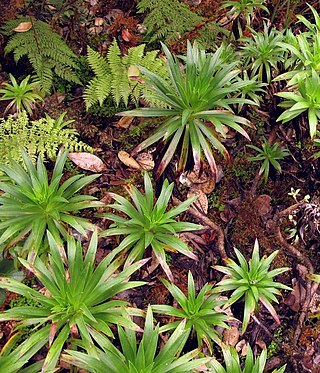Warren Herbert Wagner Jr. was an eminent American botanist who was trained at Berkeley with E.B. Copeland and lived most of his professional career in Michigan.
Ernest Brown Babcock was an American plant geneticist who pioneered the under

Willis Linn Jepson was an early California botanist, conservationist, and writer.

Asteliaceae is a family of flowering plants, placed in the order Asparagales of the monocots.

The silversword alliance, also known as the tarweeds, refers to an adaptive radiation of around 30 species in the composite or sunflower family, Asteraceae. The group is endemic to Hawaii, and is derived from a single immigrant to the islands. For radiating from a common ancestor at an estimated 5.2±0.8 Ma, the clade is extremely diverse, composed of trees, shrubs, subshrubs, mat-plants, cushion plants, rosette plants, and lianas.

Wilkesia gymnoxiphium, is a species of flowering plant in the family Asteraceae that is endemic to the island of Kauaʻi in Hawaiʻi. It is classified as endangered on the IUCN Red List. Wilkesia is one of three genera, with Argyroxiphium and Dubautia that are believed to be descendant from a single species related to the North American tarweed. The members of these three genera constitute what is called the silversword alliance, a group whose exceedingly close genetic heritage is not reflected in their exceptionally diverse morphologies.

Philip Alexander Munz (1892–1974) was an American botanist, plant taxonomist and educator who worked at the Rancho Santa Ana Botanic Garden and was a professor of botany at Pomona College, serving as dean there for three years.
The Botanical Society of America (BSA) represents professional and amateur botanists, researchers, educators and students in over 80 countries of the world. It functions as a United States nonprofit 501(c)(3) membership society.

Robert F. Thorne was an American botanist. He was taxonomist and curator emeritus at Rancho Santa Ana Botanic Garden and professor emeritus at Claremont Graduate University in Claremont, California. His research has contributed to the understanding of the evolution of flowering plants.

Argyroxiphium grayanum, commonly known as the greensword, is a species of flowering plant in the family Asteraceae, and a member of the silversword alliance, a group of over 50 species which are diverse in morphology and habitat but are genetically closely related.
Carlquistia is a rare North American genus of flowering plants in the family Asteraceae containing the single species Carlquistia muirii. Formerly named Raillardiopsis muirii, the plant was reexamined in the 1990s and moved to a new genus of its own, separate from similar and closely related genera, such as Madia. Common names for the species include Muir's tarplant, Muir's raillardiopsis, and Muir's raillardella.

Alexgeorgea is a genus of three plant species found in Western Australia belonging to the family Restionaceae named in honour of the botanist Alex George in 1976. The flowers of the female and large nut-like fruit are completely underground except for the stigmas, which extend out of the ground as 3 purple or red threads.

Grubbia is a genus of flowering plants. It is the sole genus in the family Grubbiaceae. The genus has three species, all endemic to the Cape Floristic Region of South Africa. They are shrubs that grow to 1.5 m (4.9 ft) tall, with tiny flowers and slender, leathery leaves. The fruit is a syncarp.
Frederick William Humphreys was an Australian government official and an amateur photographer and botanist whose work culminated in the posthumous publication of The Banksia Book, a book on the flowering plant genus Banksia. He discovered Banksia grossa in the Stirling Range in 1967.
Deinandra clementina, known by the common name island tarplant, is a species of flowering plant in the family Asteraceae, endemic to the Channel Islands of California.
Deiandra arida, also called Red Rock tarplant, is a rare California annual plant in the family Asteraceae.
Mildred Esther Mathias was an American botanist and professor.
Lincoln Constance was an American botanist and administrator at the University of California, Berkeley. Constance worked with Marion S. Cave for over twenty years to identify how many chromosomes different members of Hydrophyllaceae had. An expert on the parsley family, he was a fellow of the American Academy of Arts and Sciences and the California Academy of Sciences, and served as president of the American Society of Plant Taxonomists, the California Botanical Society and the Botanical Society of America.
Jose Cuatrecasas Medal for Excellence in Tropical Botany was initiated in 2001 by the Smithsonian National Museum of Natural History, USA. It is named after José Cuatrecasas, a pioneering botanist and taxonomist who worked on the flora of tropical South America. It is awarded annually to a scientist who has made a very significant contribution to advancing the field of tropical botany. Nominations for the award can be made by all in the Botany Department at the museum.
Marion Elizabeth Cave was an American plant embryologist and cytogeneticist. She obtained her PhD from University of California, Berkeley where she pioneered the approach to distinguish plant taxonomy using genetics. She continued this work at Berkeley as a research associate. While there, she would be the first person to count the chromosomes in algae, earn her a Guggenheim fellowship in 1952. In addition to her research, she was success at obtaining National Science Foundation funding to create a service that would annually inform how many chromosomes each plant species had to help the field of plant cytology flourish. For her contributions, Volume 33 of Madroño, a genus (Marionella) of Delesseriaceae, and a subgenus (Mscavea) of Echeandia were all dedicated to her.









